Abstract
This study was undertaken to evaluate the potential of a cryptococcal culture filtrate antigen, cryptococcin C184, for detecting delayed hypersensitivity in Cryptococcus neoformans-injected animals. The antigen was tested on guinea pigs which had received saline or C. neoformans and on animals sensitized to Histoplasma capsulatum, Blastomyces dermatitidis, Candida albicans, or Sporothrix schenckii. A delayed-type hypersensitivity response was elicited by cryptococcin C184 in C. neoformans-injected guinea pigs, whereas no indurations or erythemas were seen at 48 h after skin testing of saline controls or heterologously sensitized guinea pigs. Besides being specific for Cryptococcus, the antigen showed a high degree of sensitivity and was reproducible. Footpad tests were conducted with the antigen on mice which had previously received either 105 viable C. neoformans cells or saline. Delayed hypersensitivity was indicated in the C. neoformans-injected mice by the increase in thickness of antigen-injected footpads when compared with the saline-injected footpads. In control mice, antigen- and saline-injected footpads were comparable in thickness 24 h after injection. Mice sensitized to B. dermatitidis were footpad tested with C184, and no cross-reactivity was demonstrated.
Full text
PDF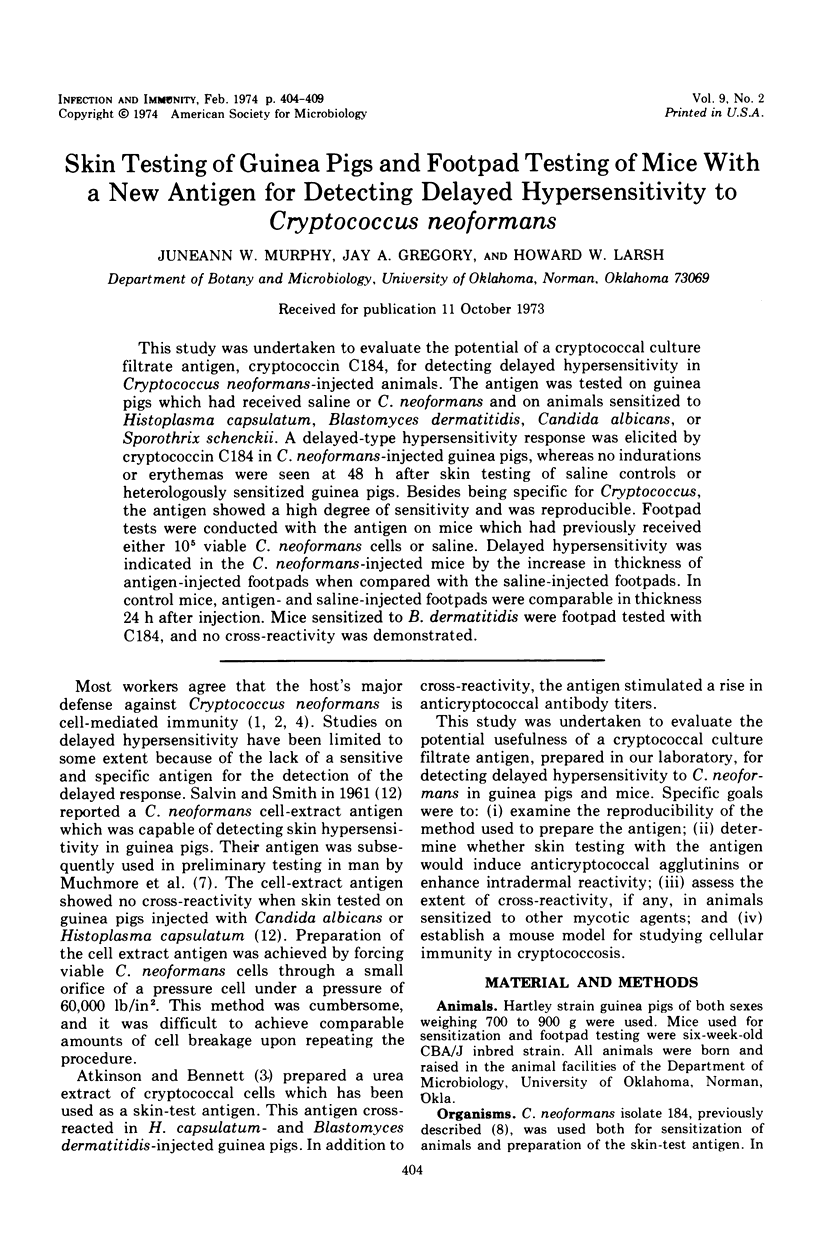

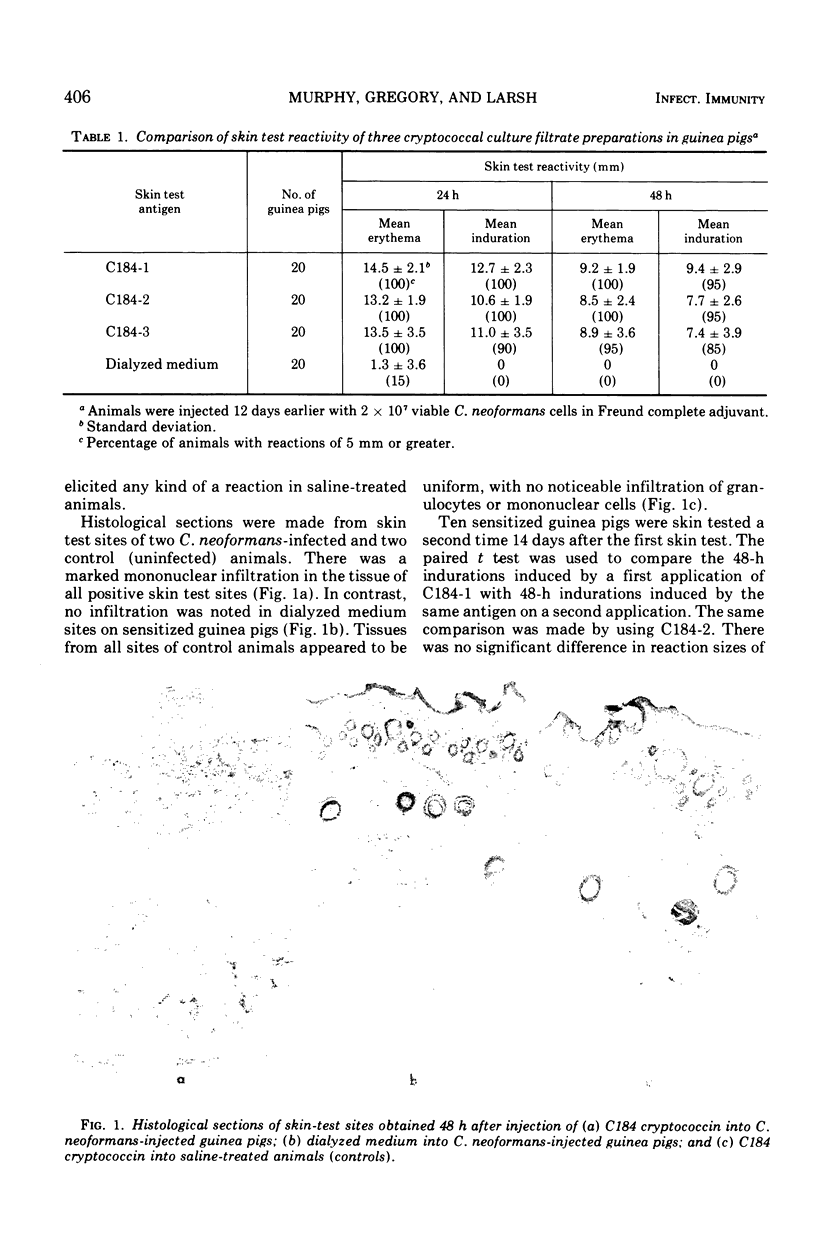
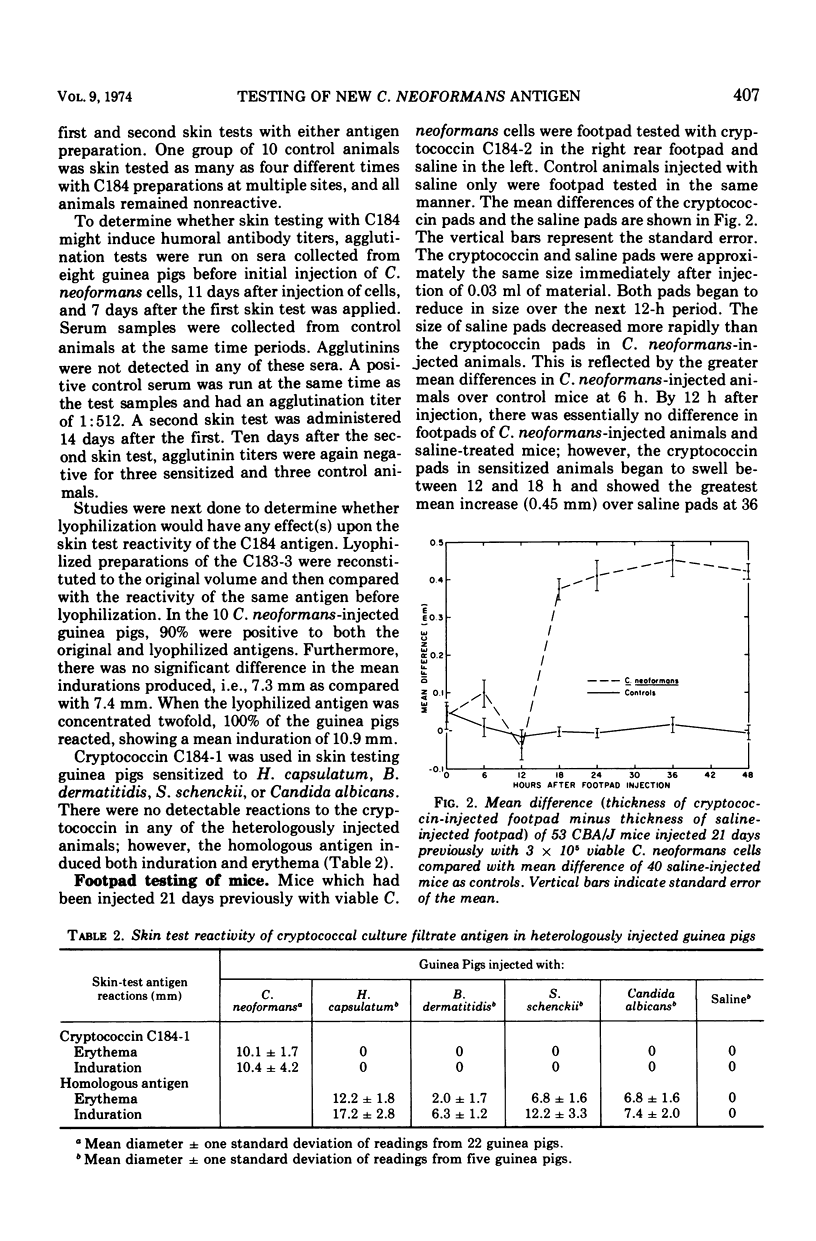
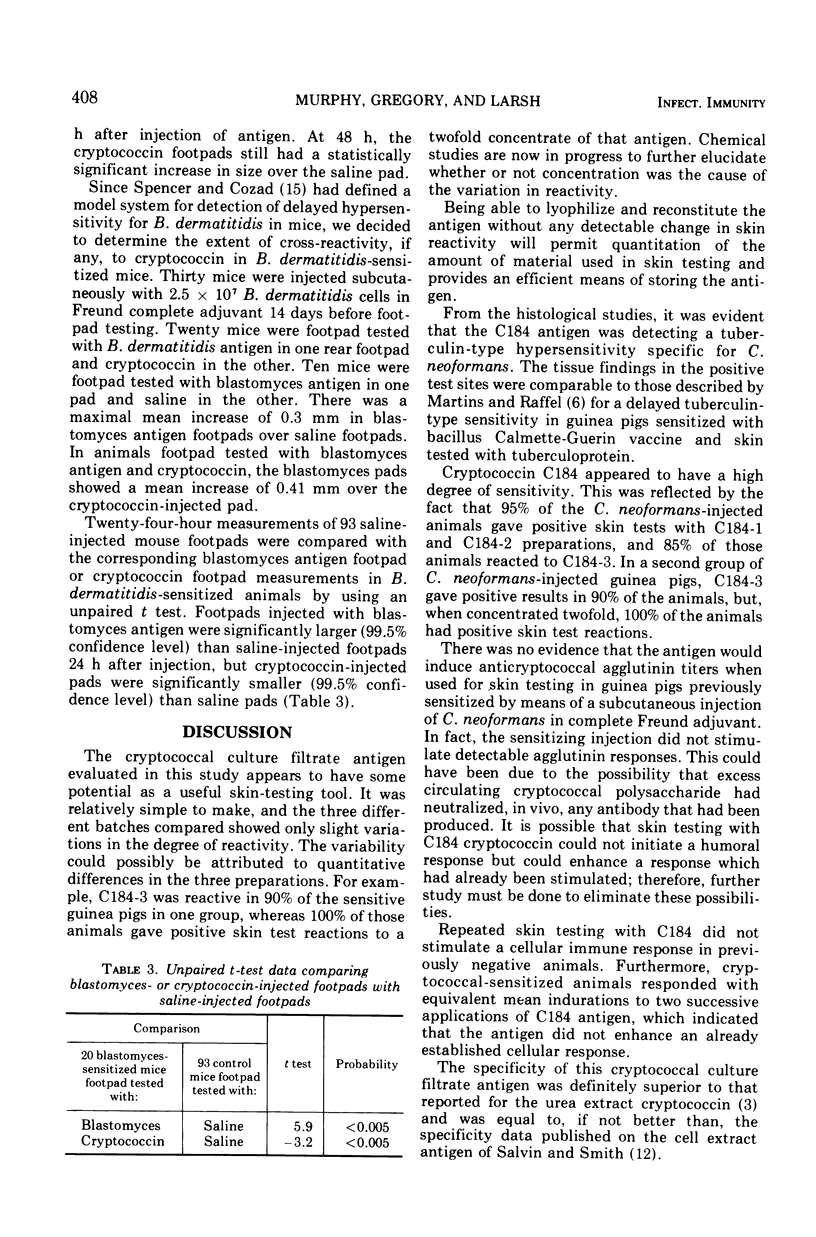
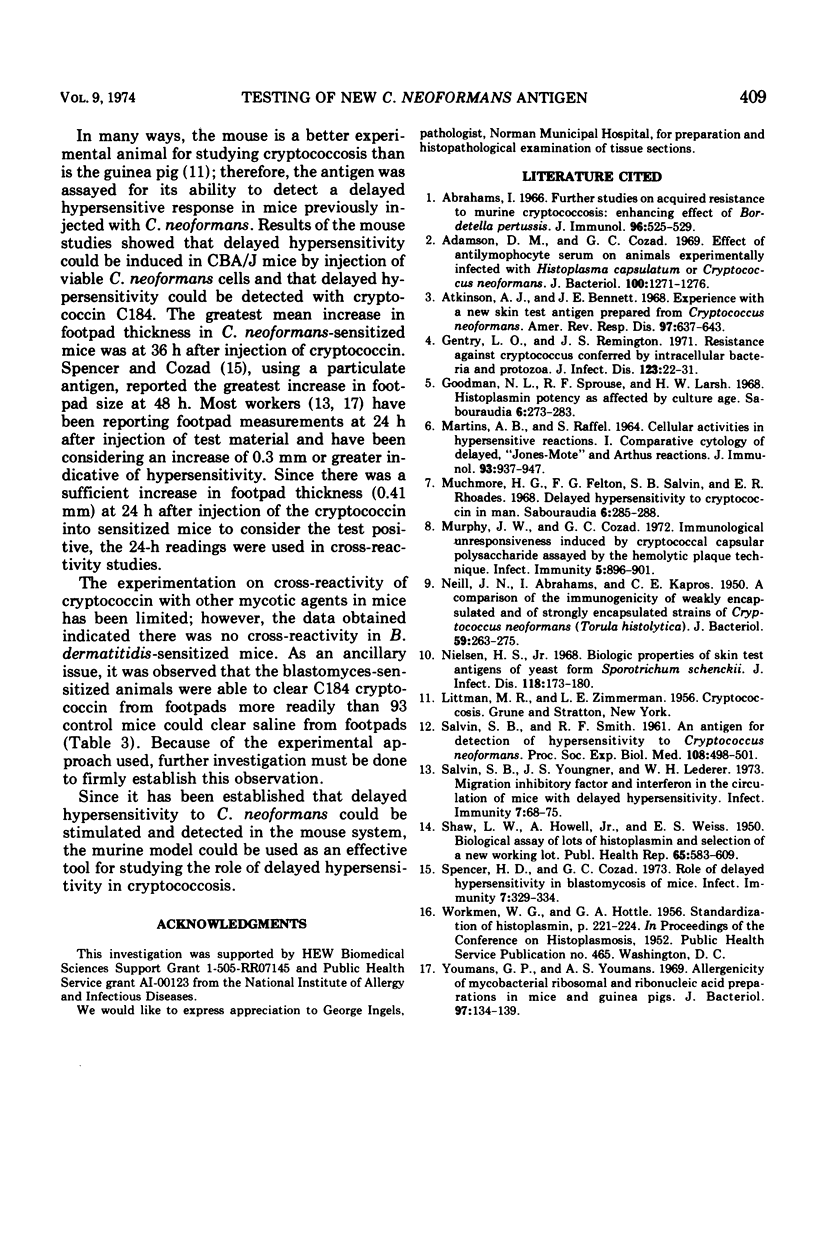
Images in this article
Selected References
These references are in PubMed. This may not be the complete list of references from this article.
- Abrahams I. Further studies on acquired resistance to murine cryptococcosis: enhancing effect of Bordetella pertussis. J Immunol. 1966 Mar;96(3):525–529. [PubMed] [Google Scholar]
- Adamson D. M., Cozad G. C. Effect of antilymphocyte serum on animals experimentally infected with Histoplasma capsulatum or Cryptococcus neoformans. J Bacteriol. 1969 Dec;100(3):1271–1276. doi: 10.1128/jb.100.3.1271-1276.1969. [DOI] [PMC free article] [PubMed] [Google Scholar]
- Atkinson A. J., Jr, Bennett J. E. Experience with a new skin test antigen prepared from Cryptococcus neoformans. Am Rev Respir Dis. 1968 Apr;97(4):637–643. doi: 10.1164/arrd.1968.97.4.637. [DOI] [PubMed] [Google Scholar]
- Gentry L. O., Remington J. S. Resistance against Cryptococcus conferred by intracellular bacteria and protozoa. J Infect Dis. 1971 Jan;123(1):22–31. doi: 10.1093/infdis/123.1.22. [DOI] [PubMed] [Google Scholar]
- Goodman N. L., Spouse R. F., Larsh H. W. Histoplasmin potency as affected by culture age. Sabouraudia. 1968 Oct;6(4):273–284. doi: 10.1080/00362176885190551. [DOI] [PubMed] [Google Scholar]
- HOTTLE G. A., WORKMAN W. G. Standardization of histoplasmin. Public Health Monogr. 1956;39:221–224. [PubMed] [Google Scholar]
- MARTINS A. B., RAFFEL S. CELLULAR ACTIVITIES IN HYPERSENSITIVE REACTIONS. I. COMPARATIVE CYTOLOGY OF DELAYED, "JONES-MOTE" AND ARTHUS REACTIONS. J Immunol. 1964 Dec;93:937–947. [PubMed] [Google Scholar]
- Muchmore H. G., Felton F. G., Salvin S. B., Rhoades E. R. Delayed hypersensitivity to cryptococcin in man. Sabouraudia. 1968 Oct;6(4):285–288. doi: 10.1080/00362176885190561. [DOI] [PubMed] [Google Scholar]
- Murphy J. W., Cozad G. C. Immunological unresponsiveness induced by cryptococcal capsular polysaccharide assayed by the hemolytic plaque technique. Infect Immun. 1972 Jun;5(6):896–901. doi: 10.1128/iai.5.6.896-901.1972. [DOI] [PMC free article] [PubMed] [Google Scholar]
- NEILL J. M., ABRAHAMS I., KAPROS C. E. A comparison of the immunogenicity of weakly encapsulated and of strongly encapsulated strains of Cryptococcus neoformans (Torula histolytica). J Bacteriol. 1950 Feb;59(2):263–275. doi: 10.1128/jb.59.2.263-275.1950. [DOI] [PMC free article] [PubMed] [Google Scholar]
- Nielsen H. S., Jr Biologic properties of skin test antigens of yeast form Sporotrichum schenckii. J Infect Dis. 1968 Apr;118(2):173–180. doi: 10.1093/infdis/118.2.173. [DOI] [PubMed] [Google Scholar]
- SALVIN S. B., SMITH R. F. An antigen for detection of hypersensitivity to Cryptococcus neoformans. Proc Soc Exp Biol Med. 1961 Nov;108:498–501. doi: 10.3181/00379727-108-26977. [DOI] [PubMed] [Google Scholar]
- SHAW L. W., HOWELL A., Jr, WEISS E. S. Biological assay of lots of histoplasmin and the selection of a new working lot. Public Health Rep. 1950 May 5;65(18):583–609. [PMC free article] [PubMed] [Google Scholar]
- Salvin S. B., Youngner J. S., Lederer W. H. Migration inhibitory factor and interferon in the circulation of mice with delayed hypersensitivity. Infect Immun. 1973 Jan;7(1):68–75. doi: 10.1128/iai.7.1.68-75.1973. [DOI] [PMC free article] [PubMed] [Google Scholar]
- Spencer H. D., Cozad G. C. Role of delayed hypersensitivity in blastomycosis of mice. Infect Immun. 1973 Mar;7(3):329–334. doi: 10.1128/iai.7.3.329-334.1973. [DOI] [PMC free article] [PubMed] [Google Scholar]
- Youmans G. P., Youmans A. S. Allergenicity of mycobacterial ribosomal and ribonucleic acid preparations in mice and guinea pigs. J Bacteriol. 1969 Jan;97(1):134–139. doi: 10.1128/jb.97.1.134-139.1969. [DOI] [PMC free article] [PubMed] [Google Scholar]



